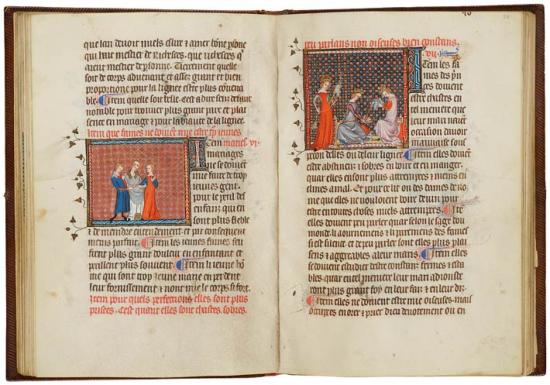
Instructions for Kings, in French
Purchased by Pierpont Morgan, 1911
The blue surcot worn by the groom in the left miniature is shorter than before. While his skirt is still full, the bodice of his surcot is now tighter, made possible by the invention of the set-in sleeve. His blue sleeves terminate at the elbow in decorative extensions, revealing the red sleeves of his kirtle. His chaperon rests on his shoulders. The bride and the three princesses in the right miniature all wear the open-sided surcot over kirtles with tight sleeves. Low, horizontal necklines reveal their bare necks and the tops of their shoulders.
Fashion Revolution
The "Fashion Revolution" began around 1330 with the invention of the set-in sleeve. Earlier garments were T-shaped, with sleeves of a piece with the body or sewn on a flat seam. The new technique (still in use today) cut sleeves with rounded tops and gathered them along basted threads into armholes in the bodice. This new tailoring, combined with the use of multiple buttons, made possible a snugly fitted bodice and tight sleeves. While providing more freedom of movement, the new garment for men—the cote hardy—also revealed the shapes of the wearer's torso and arms. The "Fashion Revolution" gave birth to men's modern dress, creating an outfit that was sharply differentiated from the dress of women.
Women's fashions, however, were also affected. Tighter bodices and sleeves became popular, as did exposed necks and shoulders. The sides of the outer garment, the surcot, now sometimes featured seductively large, peek-a-boo openings.
Men—and some women—turned the chaperon (a hood with an attached cape and tail) into a fashion accessory that lasted over a hundred years.
